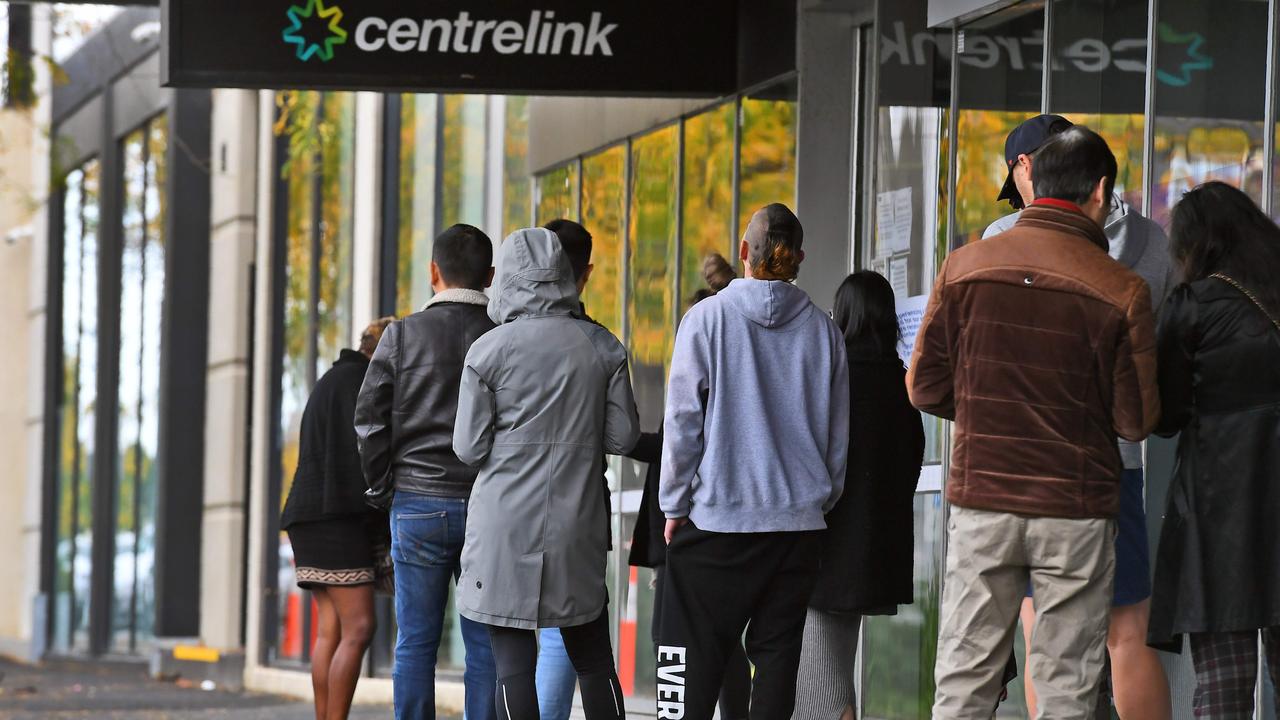JobKeeper: Unemployment rates rise, what true figures mean for future
Australia’s “devastating” jobs figures have just been revealed – but one baffling number managed to hide the true extent of the carnage.
Australia received the “heartbreaking” news that almost 600,000 workers had lost their job in just one month yesterday.
But at the same time, the unemployment rate had only jumped by 104,500, taking it to 6.2 per cent, compared to the previous month’s 5.2 per cent.
On the surface, that mere one per cent difference doesn’t seem too disastrous.
But the reality of our current jobs market is far more complicated – and far more worrying.
THE DATA
According to the Australian Bureau of Statistics, seasonally adjusted employment fell by 594,300 people between March and April.
That equates to about 19,810 jobs lost each day during that period.
Unemployment increased by 104,500 people to 823,300, the unemployment rate increased by 1 percentage point from 5.2 per cent to 6.2 per cent and total hours worked fell by around 9.2 per cent between March and April.
RELATED: PM fears ‘even deeper impact’
RELATED: Shock collapse of denim empire
TRUTH BEHIND 1 PER CENT JUMP
The ABS explained that the comparatively small jump in unemployment – even as almost 600,000 jobs were lost – was the result of a drop in people actively looking for employment.
“The large drop in employment did not translate into a similar-sized rise in the number of unemployed people because around 489,800 people left the labour force,” stated Bjorn Jarvis, head of labour statistics at the ABS.
The spike in people leaving the labour force also meant the participation rate plummeted by 2.4 percentage points to 63.5 per cent.
Crucially, Australians who are not “participating” in the “labour force” are not considered to be unemployed, nor are those who have been “stood down” but who expect they may keep their job in future, therefore driving down the overall rate.
Given the widespread government restrictions that have forced businesses to close, it is believed many out of work Aussies have hit pause when it comes to trying to find a new job, as there’s simply no point at the moment.
EY Chief Economist Jo Masters said the situation was likely to “get worse before it gets better”, despite the easing of restrictions.
“While the lower participation rate cushioned the rise in the unemployment rate, which jumped to 6.2 per cent, well below expectations of 8.3 per cent, this figure is not good news given it is driven by people leaving the workforce” she explained.
“Indeed, this data suggests getting people back to jobs will be even more challenging as they will first need to be enticed back in to the workforce, and then find a job.”
And Callam Pickering, APAC Economist at global job site Indeed, said the figures “didn’t pass the pub test” and did not “do justice to the economic destruction”.

“Australia’s under-utilisation rate jumped to 19.9 per cent, with the unemployment rate rising to 13.7 per cent, while hours worked fell by 9.2 per cent. That does a better job, than the unemployment rate, of measuring the economic impact of COVID-19,” he said.
“Employment fell by 594,300 people in April but unemployment jumped by only 104,300 people. That obviously doesn’t pass the pub test. Due to methodology, which doesn’t always sit well with reality, 489,800 people simply left the Australian labour force in April. Had the size of the labour force held steady, with everyone losing employment shifting to unemployment, then the unemployment rate would have spiked to 9.6 per cent.
“The rate of unemployment would also be much higher in the absence of the JobKeeper wage subsidy. The subsidy is imperfect – failing to cover vulnerable casual workers and – but it has preserved the connection between business and employee.”
JOBKEEPER
Meanwhile, the six million-odd Australians now receiving the JobKeeper wage subsidy are also not factored in – even if they’re working zero hours.
Speaking to ABC News yesterday, the Grattan Institute’s Danielle Wood said that has “significantly” masked the true extent of the economic damage caused by the coronavirus crisis.
“I mean certainly in terms of the number of people becoming unemployed, (it) is extremely high by historical standards and the rate we are seeing unemployment shoot up again is like nothing we have ever seen,” she said.
“So in terms of that headline unemployment figure, certainly a bit lower than what we are expecting, but it does really bring home just how significant and how fast this shock has been.”
During a press conference following the release of the ABS figures, Prime Minister Scott Morrison also touched on whether the exclusion of JobKeeper disguised the true story.
RELATED: How JobKeeper scheme flopped

“When you get underneath the numbers I think what you’ll see is the estimates that Treasury put together earlier are reflected in these numbers,” he said.
“While the headline rate is just over six (per cent), when you have almost 600,000 people exit employment, that is a devastating set of numbers.
“And when you look at hours worked and all of those issues as well what you do see is an even deeper impact.”
Meanwhile, Treasurer Josh Frydenberg said it was a “tough day” and that the figures were “heartbreaking” – but that Australia had “confronted this global pandemic, this economic shock … from a position of economic strength.”




